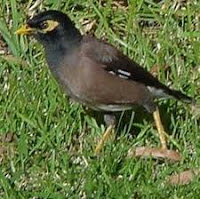Identification
The new species is a small scops owl
about 17 cm in length, with a short tail, and almost uniformly rufescent
upperparts but for the presence of small black spots all over the body.
The face is a little darker, and underparts paler than upper parts,
with the belly becoming whitish. It has no distinct, “true” ear-tufts,
but see below. The irides are orange-yellow in the male and yellow in
the female and juvenile. The beak, legs and claws are whitish. The legs
are feathered on the tibia and upper tarsi.
Behavior
At the time of the type description we
knew that birds of a pair roosted fairly close together or well apart
within their territory. Later we learnt that in some pairs the birds
roost together or very close. A fledgling has been observed roosting
with an adult male. Roosting height varies from about 1 to 2.5 m. A
well-concealed place is chosen in dense vegetation in the undergrowth or
just above it. Here the bird sits on an almost or entirely horizontal
twig, usually close to dead leaves. Its size, shape and coloration blend
it in perfectly with the surroundings, making it hard to detect. When
an owl is in “alert mode” at its daytime roost, in reaction to possible
danger in the vicinity, it quickly adopts a stance which disguises it as
a short, upright, broken branch. It tightens body feathers, which are
otherwise loose and relaxed, to acquire a narrower appearance. At the
same time it adjusts the feathers of the facial disk, forehead and crown
to give the appearance of the top of such a branch. This latter
arrangement is adopted also by species of owl which have two obvious,
separate ear-tufts, which are erected to enhance this effect. The
Serendib Scops Owl, which does not possess ear-tufts, achieves a similar
effect by compressing and flattening feathers on the forehead,
forecrown and sides of the facial disk, and folding feather tracts on
the forehead at the edges of the disk over the inner part of the eyes.
This makes the top left and right edges of the disk stand out, with also
the support of adjacent crown feathers, giving an impression of short
ear-tufts. Another result is an obvious, broader and deeper V on the
forehead, showing up more white, than in a bird in “relaxed mode”. At
night the Serendib Scops Owl adopts this “pseudo-eartuft” arrangement
only very rarely, according to our observations, probably because there
is no significant advantage of such visual camouflage in the dark. It
has been known that in similar situations species of owls lacking true
ear-tufts adopt a camouflage pose which suggests the presence of small
ear-tufts.
Location
Endemic to Sri Lanka, found thus far
only in the southwest quarter of the island at Kitulgala, Kanneliya and
Eratna-Gilimale Reserves, with its strongholds in the Sinharaja and
Morapitiya-Runakanda reserves, which are contiguous.






















